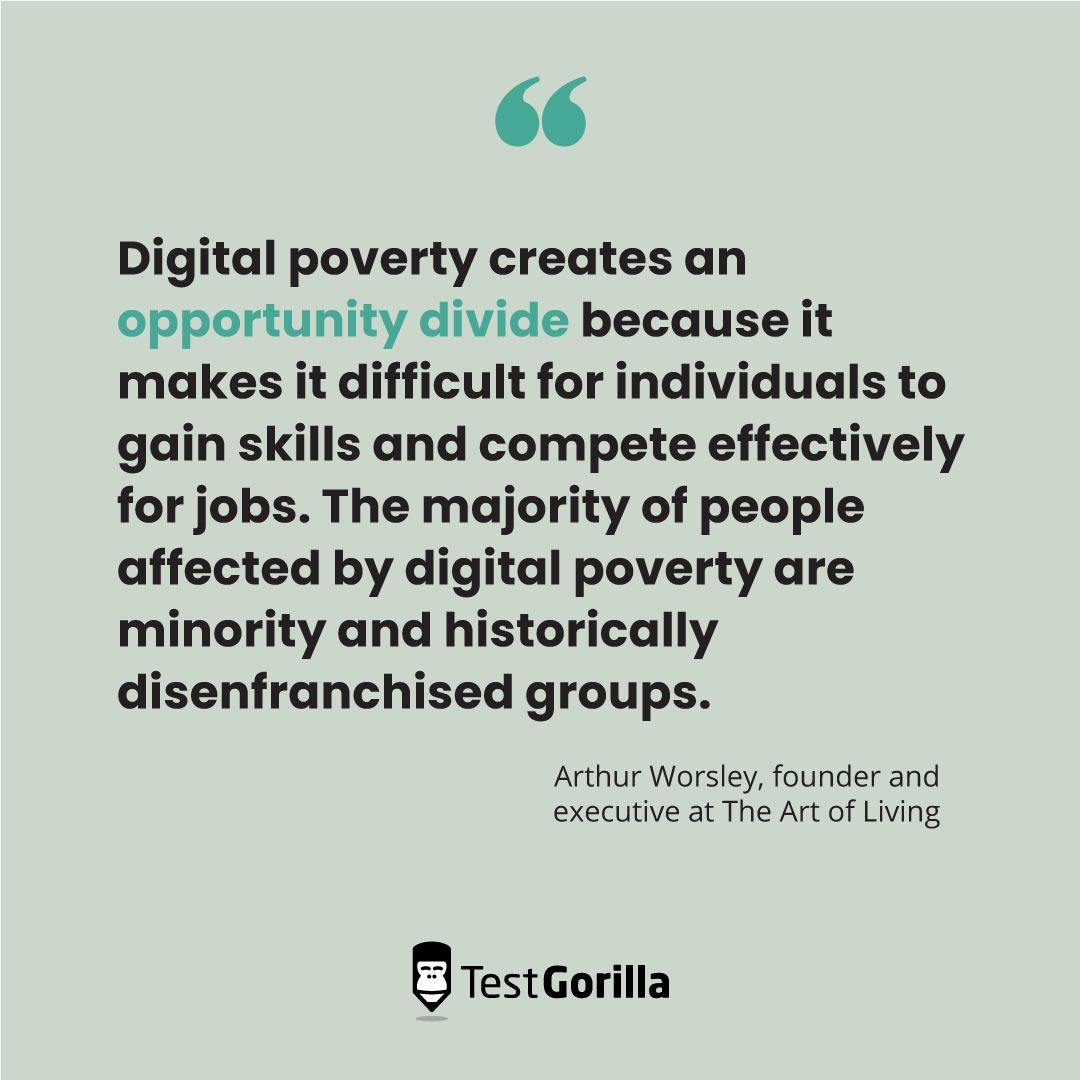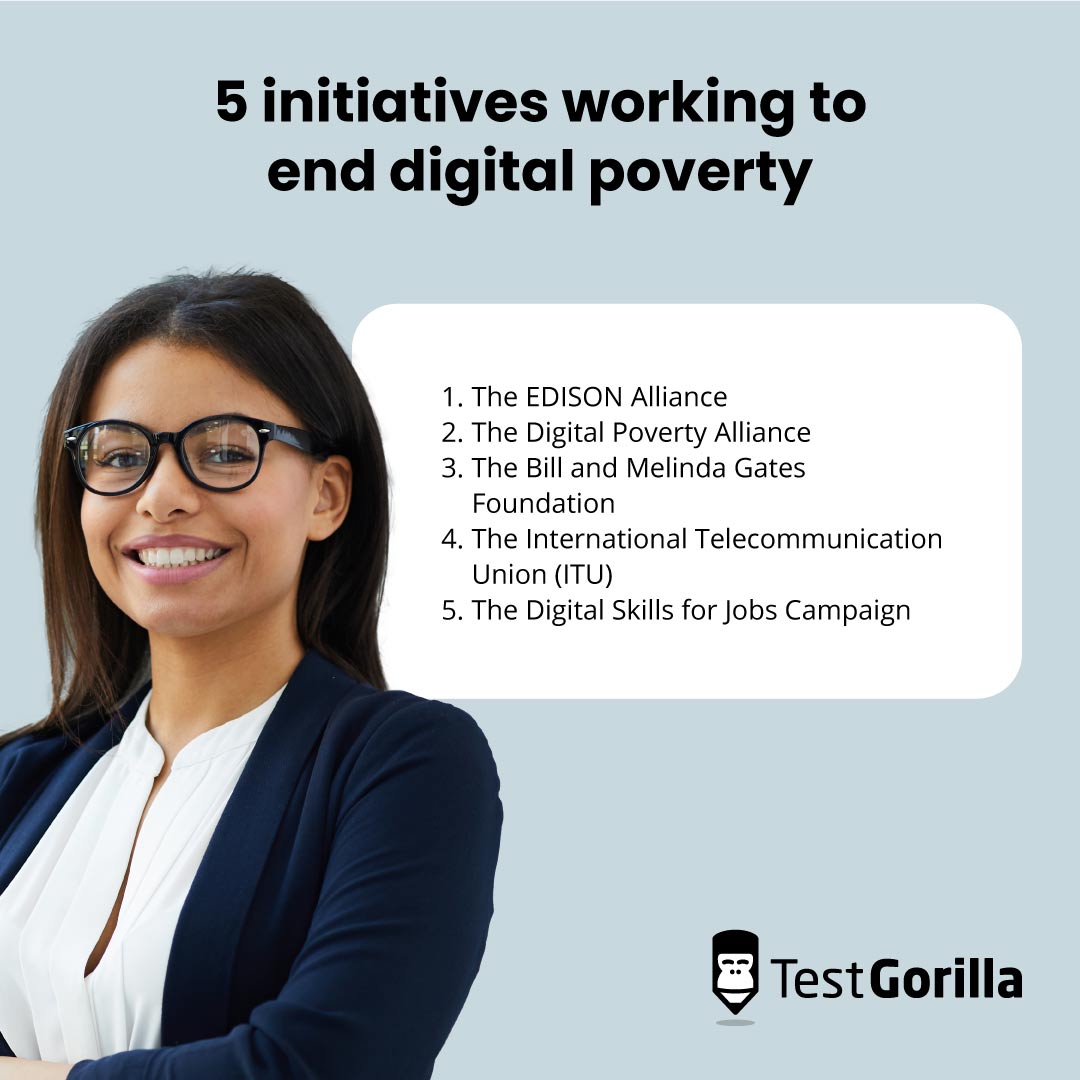Whether you’re working in tech or a factory, digital skills are required for most roles and sectors. Unfortunately, many people lack the necessary resources and skills to compete in a digital environment.
At the same time, the remote working revolution has opened up new opportunities for underrepresented groups including women, people of color, people in developing regions, and individuals with disabilities. Remote work has created a bigger, more diverse talent pool for companies to hire from.
However, limited access to technology, reliable infrastructure, or opportunities to develop digital skills remain barriers for many. This is known as digital poverty, or the digital divide.
There is an urgent need to close the digital divide to provide equal access to job opportunities and the flexibility and freedom that remote working offers. This can help close pay gaps by helping marginalized workers gain higher-level skills and access higher-paying jobs.
With the rise of skills-based hiring, it’s also more important than ever that all candidates have digital access to complete online assessments.
In this article, we look at five initiatives aimed at tackling digital poverty and closing the digital divide around the world – and what you can learn from them. Read on to gain valuable insights into tried and tested schemes to end digital poverty and get inspired in your own D&I and hiring strategies.
Table of contents
What is digital poverty and why should you care?
Digital poverty is a lack of access to technology and Internet connectivity — and, therefore, an uneven distribution of digital skills and knowledge.
“Digital poverty creates an opportunity divide because it makes it difficult for individuals to gain skills and compete effectively for jobs,” says Arthur Worsley, founder and executive at The Art of Living.
He adds: “The majority of people affected by digital poverty are minority and historically disenfranchised groups including indigenous people, people with disabilities, as well as marginalized ethnic and racial communities. As a result, there’s a significant lack of diversity and a drop in quality in the labor market, which affects the type of talent that HR is able to hire. This then affects a company’s long-term competitiveness, profitability, and market share.”
All of this means disenfranchised pockets of the global population are being left behind by the “digital revolution,” adding to an increasing digital skills gap. Since 3.7 billion people are digitally excluded worldwide, you’ll likely be affected by the lack of skilled and diverse talent you need to run successful and motivated teams.[1]
This has important implications for current and future generations of workers. In the UK alone, one in five children don’t have access to the tools that make digital education possible — and over one in 20 don’t have Internet.[2]
Candidates experiencing digital poverty may not be able to complete an online hiring process or work remotely.
According to our 2022 State of Skills-Based Hiring report, skills-based hiring is gaining traction as a fairer and more equitable way to recruit top talent. Ninety-one percent (91%) of employers see an increase in diversity after using skills-based hiring methods.
This has led to a growing emphasis on skills-based hiring as well as testing candidates on the skills necessary for the role before they’re hired.
However, the digitally impoverished may have difficulty demonstrating their skills in a digitally literate world. This means companies are accessing only a portion of the diverse talent out there and potential employees aren’t competing on a level playing field.
5 initiatives working to end digital poverty
How can we close the digital divide and end digital poverty? How can we make sure that all candidates have the digital access needed to reap the benefits of skills-based hiring?
To help answer these questions, we can analyze and learn from existing initiatives working to end digital poverty.
By understanding what’s being done, what’s working well, and how to apply key strategies, you can plan how to support those affected by digital poverty, build diverse teams, and access talent in underserved communities.
Let’s unpack five initiatives working to end digital poverty.
1. The EDISON Alliance
Launched by the World Economic Forum, The EDISON Alliance brings governments and organizations together to close the digital divide in health, finance, and education.
It is currently spearheading the “1 Billion Lives Challenge”, which aims to improve the lives of one billion people by providing affordable and accessible digital solutions by 2025.
The EDISON Alliance also speeds up collaboration between the private and public sector by:
Creating a network of leaders who are dedicated to fostering digital inclusion
Enabling knowledge sharing and events to shape the digital inclusion agenda
Cultivating visibility into cross-governmental and organizational initiatives
There are several lessons we can learn from The EDISON Alliance when it comes to closing the digital divide:
Collaboration is key: The EDISON Alliance is a coalition of companies, governments, and organizations working together towards a common goal. By pooling resources and expertise, they can make a greater impact than any one organization could on its own.
Multi-pronged approach: The Alliance tackles digital poverty from multiple angles, including providing access to technology and the Internet, offering digital skills training, and advocating for policy change. This multi-pronged approach recognizes that there is no single solution to digital poverty and that a comprehensive strategy is necessary.
Importance of public-private partnerships: The EDISON Alliance includes both private sector companies and government entities. This allows the private sector to leverage its unique resources and expertise, while government entities can provide regulatory and policy support and different perspectives.
Focus on equity: The Alliance understands that digital poverty disproportionately affects marginalized communities and prioritizes equity in its approach. For example, by targeting resources to communities in most need.
Long-term thinking: The Alliance recognizes that addressing digital poverty is not a quick fix and requires a sustained effort over time. Its approach is, therefore, focused on long-term solutions with the potential to create lasting change.
2. The Digital Poverty Alliance
The Digital Poverty Alliance is an advocacy organization that works to bring public, private, and third sectors together to end digital poverty in the UK.
Much like the EDISON Alliance, it uses these partnerships to pool resources and generate pledges for the cause. It also creates community spaces where people from different industries, roles, and backgrounds can come together to co-create viable solutions.
On top of advocacy work to bring visibility and action to closing the digital divide, the Digital Poverty Alliance is also building a body of information to create the right policy solutions.
This means it actively publishes evidence reviews and creates the literature needed to evaluate potential solutions and put forward recommendations for real change. It also invites potential feedback and funding opportunities.
Here are the major takeaways:
Build an evidence base to state your case: By presenting data and evidence, advocates can make a compelling case for why addressing digital poverty is important and why specific interventions are needed. They can also inform the development of policies and programs aimed at reducing digital policy. For example, evidence may suggest that providing low-cost Internet access or digital skills training can be effective interventions.
Move forward with proof-of-concept (PoC) projects: There’s great value in small-scale projects that have been tested and proven to be viable in a smaller or experimental setting. Once a PoC has been successfully demonstrated, it can then be further developed and refined. For example, the Digital Poverty Alliance has taken forward PoC programs such as Tech4Teachers and Tech4PrisonLeavers to tackle the digital divide.
3. The Bill and Melinda Gates Foundation
In addition to working to lift people out of hunger and extreme poverty globally, the Bill and Melinda Gates Foundation focuses on reducing the gender gap with regard to digital connectivity.
Women are among the groups most impacted by digital poverty due to lack of access, low digital literacy, online safety issues, a lack of confidence in their digital skills, and lack of role models.
Sixty-two per cent (62%) of young males are interested in a digital career, compared to 42% of young women.[3] This is reflected in stark gender gaps in confidence, participation in Information and Communications Technology (ICT) courses at school, apprenticeships, higher education, and in the tech workforce.
Additionally, according to the Foundation, “Despite growing investments in digital solutions for health and development, women continue to be left behind across geographies and income segments.”[4]
The Bill and Melinda Gates Foundation works to address the gender digital divide by:
Supporting action-oriented research and innovation on digital interventions that can close the gap. For example, its partnership with the United Nations Development Program (UNDP) to launch the “Digital Inclusion Platform” initiative. This platform aims to provide a space for collaboration, knowledge-sharing, and learning among stakeholders working to promote digital inclusion and bridge the digital divide.
Developing testing tools and platforms to better understand gender-specific barriers. For example, it has partnered with the International Telecommunication Union (ITU) to develop the Digital Inclusion Index: a tool to measure the state of digital inclusion in countries around the world.
Advocating for digital connectivity to improve the health, homes, and livelihoods of women. For instance, it supports initiatives aimed at expanding broadband access, reducing the cost of Internet service, and promoting digital inclusion policies.
Connecting researchers from across the world for access to broader perspectives, experiences, and solutions.
Developing digital skills training and programs that teach digital literacy, coding, and other skills to help people take advantage of technology for education and employment.
4. The International Telecommunication Union (ITU)
The ITU is a United Nations agency for communication and communication technologies. It’s known for its active involvement in reducing digital poverty, particularly its efforts to promote universal access to ICT worldwide. As well as securing partnerships with influential stakeholders and organizations like The World Bank, UNICEF, and UNESCO.
The ITU also partnered with the Bill and Melinda Gates Foundation to create the Digital Inclusion Index (DII), which takes into account factors such as access, affordability, skills, and usage. It also provides a framework for policymakers and other stakeholders to identify areas where action is needed.
According to the ITU, significant strides are being made to close the digital divide. For example, the cost of Internet services decreased across the globe in 2022, dropping from 1.9% to 1.5% of the average gross national income (GNI) per capita.[5] Moreover, almost 75% of the global population aged 10 and above now own a mobile phone, and 75% of young people worldwide now use the Internet.
However, the global gap still remains: For the average consumer in a typical low-income economy, the cheapest mobile broadband package costs more than 9% of their income.[6]
What can you learn from the ITU when it comes to combating digital poverty?
Provide resources and training materials: Help organizations and governments develop a strategy for enabling digital skills. For example, the ITU developed a Digital Skills Toolkit translated into six languages to help countries and companies develop the language, framework, and strategy to combat digital poverty.[7] It arms them with practical information, examples, and step-by-step guides to help develop a national digital skills strategy. It can also be used to develop policies and programs to address specific needs and priorities.
Focus on access to technology and education in digital skills: This includes efforts to promote digital literacy, provide training and certification programs — as well as learn the tech itself — and support entrepreneurship and innovation.
Track and measure progress: By developing a composite index that takes into account a range of factors, the ITU provides a framework for policymakers and other stakeholders to track progress over time, learn from previous successes or failures, and iterate.
5. The Digital Skills for Jobs Campaign
Spearheaded by the ITU and the International Labor Organization (ILO) the Digital Skills for Jobs campaign seeks to equip five million young people with job-ready digital skills by 2030.
It’s doing this by:
Implementing digital skills projects across the world
Creating jobs for young people with digital skills
Funding digital skills development programs for young people, including programs targeting young women
Building links between employers and digital skills training providers to foster job placement
Initiating in-demand digital skills curricula in education, apprenticeships, and other skilled through alternative routes (STAR) organizations
Although the results aren’t in yet, here’s what we can learn from this campaign:
Ask organizations and governments to make a commitment: Asking people to commit to supporting the youth and tackling digital poverty is a win-win: you get another partner to support your cause. Meanwhile, they get global recognition as a “Digital Skills Champion” through their campaign pledge.
Set ambitious targets: This helps you focus your efforts and provide a clear framework for measuring progress.
Offer flexible training approaches: The campaign recognized that traditional training approaches may not be suitable for everyone and emphasized the need for flexible, innovative training approaches. This included initiatives such as online courses, coding boot camps, and the development of digital badges to recognize skills acquired outside of traditional education pathways.
Provide opportunities for continuous learning: Digital skills are constantly evolving, which means you need to promote lifelong learning, upskilling, and reskilling, and provide training and support for those who have been displaced from traditional jobs due to technological change.
Use skills-based hiring to help put an end to digital poverty
You might be wondering how skills-based testing can help end digital poverty, especially since digitally impoverished candidates don’t necessarily have an online presence. However, by offering different testing formats (online and in-person) or adapting testing requirements, you can accommodate limited digital resources.
You can also partner with community organizations that work with digitally impoverished individuals to provide training and support for test-takers. This can help provide access to technology and resources, as well as offer guidance throughout the testing process.
Close the digital divide with these initiatives as your guide
Technology is shifting the requirements of almost every job, regardless of industry or sector. However, digitally impoverished people don’t have access to the technology needed to advance their digital skills and careers. This contributes to a growing divide between available digital skills and open roles. Additionally, it lowers the number of diverse people who can apply for those roles.
In this article, we examined five initiatives aimed at tackling digital poverty and closing the digital divide around the world – as well as important takeaways you can turn to and inspire your own efforts.
These initiatives show us how organizations and individuals alike can collaborate with existing initiatives or create their own programs to address digital poverty. This might involve providing access to digital devices, offering digital literacy workshops, or partnering with educational institutions and governments to create more inclusive digital curriculums.
When you combine that with a skills-based approach to hiring, you can enable individuals from a range of backgrounds and experiences to showcase their skills and compete for digital jobs. This helps create a more diverse and inclusive digital economy, and brings us one step closer to ending digital poverty.
Want a better way to hire diverse talent? Skills-based hiring helps you access top-tier workers with the right competencies all over the world. Download the State of Skills-based Hiring 2022 report to learn more.
Sources
“Measuring digital development: Facts and Figures 2022.” (2022). ITU. Retrieved May 2nd, 2023. https://www.itu.int/en/ITU-D/Statistics/Pages/facts/default.aspx
“Disconnected? Exploring the digital skills gap”. (2021). Learning and Work Institute. Retrieved May 2nd, 2023. https://learningandwork.org.uk/resources/research-and-reports/disconnected-exploring-the-digital-skills-gap/
“Disconnected? Exploring the digital skills gap”. (2021). Learning and Work Institute. Retrieved May 2nd, 2023. https://learningandwork.org.uk/resources/research-and-reports/disconnected-exploring-the-digital-skills-gap/
“Digital Connectivity.” (n.d.) Gates Foundation. Retrieved May 2nd, 2023. https://www.gatesfoundation.org/our-work/programs/gender-equality/digital-connectivity
“Internet more affordable and widespread, but world’s poorest still shut off from online opportunities.” (2022). ITU. Retrieved May 2nd, 2023. https://www.itu.int/en/mediacentre/Pages/PR-2022-11-30-Facts-Figures-2022.aspx
“Measuring digital development: Facts and Figures 2022.” (2022). ITU. Retrieved May 2nd, 2023. https://www.itu.int/en/ITU-D/Statistics/Pages/facts/default.aspx
“Digital Sales Toolkit.” (2018) ITU and Decent Jobs for Youth. Retrieved May 2nd, 2023. https://www.decentjobsforyouth.org/wordpress/wp-content/uploads/2018/04/Digital-Skills-Toolkit.pdf
Related posts
Hire the best candidates with TestGorilla
Create pre-employment assessments in minutes to screen candidates, save time, and hire the best talent.
Latest posts
The best advice in pre-employment testing, in your inbox.
No spam. Unsubscribe at any time.

Hire the best. No bias. No stress.
Our screening tests identify the best candidates and make your hiring decisions faster, easier, and bias-free.
Free resources
This checklist covers key features you should look for when choosing a skills testing platform
This resource will help you develop an onboarding checklist for new hires.
How to assess your candidates' attention to detail.
Learn how to get human resources certified through HRCI or SHRM.
Learn how you can improve the level of talent at your company.
Learn how CapitalT reduced hiring bias with online skills assessments.
Learn how to make the resume process more efficient and more effective.
Improve your hiring strategy with these 7 critical recruitment metrics.
Learn how Sukhi decreased time spent reviewing resumes by 83%!
Hire more efficiently with these hacks that 99% of recruiters aren't using.
Make a business case for diversity and inclusion initiatives with this data.





















